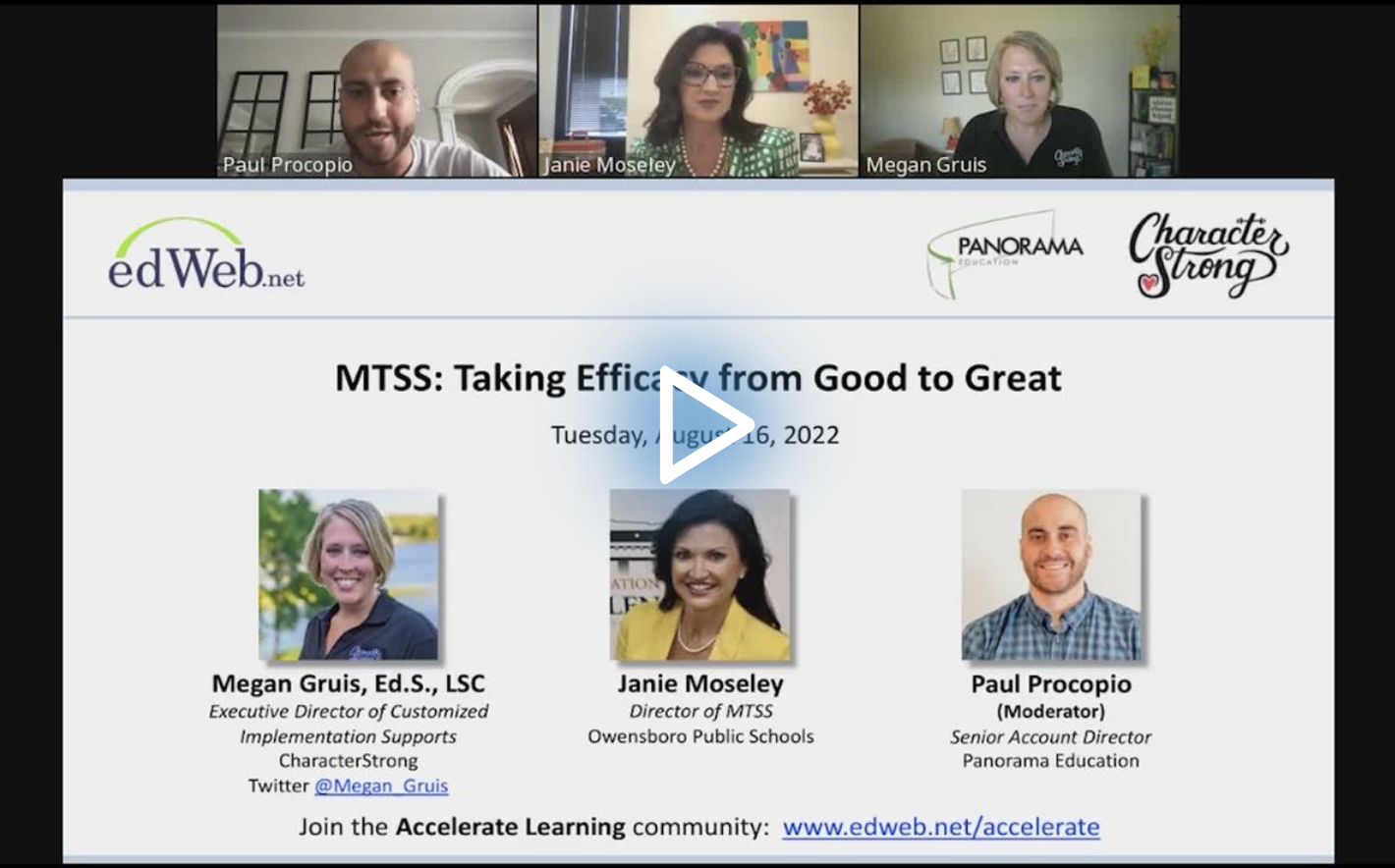Implementing Effective MTSS Programs for Student Success
Watch the Recording Listen to the Podcast
For any educator or administrator looking to build a comprehensive support system for students, the edLeader Panel, “MTSS: Taking Efficacy from Good to Great,” is a must-watch discussion. The panelists discussed how Multi-Tiered Systems of Supports (MTSS) improve school environments, academic achievement, and student behavior.
The conversation had two parts: a practical case study from the Owensboro Public Schools (KY) covering what a successful MTSS intervention looks like, followed by a breakdown of how to replicate a successful implementation of this type of program in your district.
Janie Moseley, Director of MTSS for Owensboro, shared how she began building support systems years ago as an elementary school principal. Facing high transiency rates with a large population of at-risk students, Moseley quickly recognized that students needed additional support and that she and her staff had a tight timetable to intervene.
She developed processes to identify problems, collect data, and document successful interventions, but still faced an issue: though she had tremendous success while students were in her school, there was no method to capture best practices from interventions for students once they left elementary school.
The next step was to brainstorm how to track best practices on a larger scale and create indicators that would work across different schools. Moseley moved into a district-level role and focused on creating universal screening systems to get the schools in the Owensboro district on the same page about what indicators to use to identify student needs and how to flag when students were in need of additional support.
The two biggest barriers quickly became evident: the schools lacked uniform indicators of student wellbeing across the district, and despite having great staff members that were changing students’ lives, there was no official process in place for documenting successful interventions in any of the schools.
Once student wellbeing indicators were defined, multifunctional teams of counselors, administrators, educators, and more needed to be empowered to work interdependently, building processes together to support students instead of operating in silos. Building a core MTSS team at each school was a crucial step in that process. Once core teams were in place and uniform indicators for student wellbeing were defined, the next step was to provide access to reliable data in order to diagnose and address student problems.
At this point, Owensboro Public Schools engaged the Panorama Social-Emotional Learning (SEL) platform and the Student Success Platform uniformly across schools. By capturing indicators for student wellbeing in one place, for the first time, Moseley could analyze indicators across schools and could see a clear picture of interventions’ successes.
Over the summer, she worked to teach the core MTSS teams how to analyze and implement takeaways from the data. This school year, Moseley and her team plan to take a step further and implement Panorama’s Behavior Analytics tool to proactively create an early warning tool and trigger additional support systems for students. Additionally, they plan to continue monitoring MTSS core teams’ progress and providing them with resources to ensure the sustainability of these systems in the long term.
Megan Gruis, Ed.S., LSC, Executive Director of Customized Implementation Supports at CharacterStrong, then walked through how to implement and sustain a new program. Whether it’s a program as complete as MTSS, or a smaller part such as SEL, academics, or behavior initiatives, CharacterStrong advocates for three pillars of implementation: clarity about what needs to happen, competence about processes and best practices, and consistency to ensure the most important parts of the program are sustained in the long term.
The first step in achieving clarity is defining clear outcomes and setting a vision for student wellbeing. The outcomes that measure wellbeing are best defined using systems, data, and practices to analyze which indicators are effective. Then, it is crucial to share the vision in order to get all stakeholders on board—especially those leading the program implementation on the ground.
Providing support systems for educators helps them to understand what they need to do and deliver in order to achieve those outcomes. Infusing data can also help administrators and educators to be able to visualize why the outcomes are important and understand how gaps in achievement impact students.
Once the outcomes, and effective indicators to measure them, are defined, team leaders can focus on competence. After clarifying outcomes, program leaders must ask: What practices are we asking educators to implement every day in order to deliver outcomes with fidelity and over time? And, what resources do they need in order to do so?
By looking at data that tracks indicators across SEL, teaching, and environment, teams can analyze how processes interact with one another and evaluate which interventions are effective in reaching outcomes. Using a diagnostic tool is crucial, and the CharacterStrong team recommended platforms like Panorama to track progress, identify root causes of problems, and create intervention plans.
Lastly, the most important part of the equation in the long term is consistency. Gruis pointed out two key facts: students can’t benefit from ineffective interventions implemented well, but also don’t benefit from effective interventions that are implemented poorly. For example, the behavior chart is an ineffective tool that is often “implemented well” in classrooms. But, when delivered poorly, even the best SEL lesson will flop.
Getting over the implementation gap is crucial for a successful program in the long term. The best way to do that is to think about what students are realistically able to access consistently, how we are supporting adults to deliver the work on a long-term basis, and if the school environment is providing a climate that permits the implementation to motivate educators as they implement solutions.
Overall, the conversation provided a crucial lens into how to implement complex MTSS programs and ensure their sustainability over time. Having a clear vision in mind, a multifunctional team in place, a reliable platform to collect data on students’ wellbeing, and a sustainable strategy to implement data-informed interventions over time is clearly the winning formula to ensure students flourish in school districts all across the country.
Learn more about this edWeb broadcast, “MTSS: Taking Efficacy from Good to Great,” sponsored by Panorama Education in partnership with CharacterStrong.
Watch the Recording Listen to the Podcast
Join the Community
Accelerate Learning is a free professional learning community that helps educators learn and share ideas for meeting students where they are in their learning and accelerating their progress.


Blog post by Laura Smulian, based on this edLeader Panel





Comments are closed.